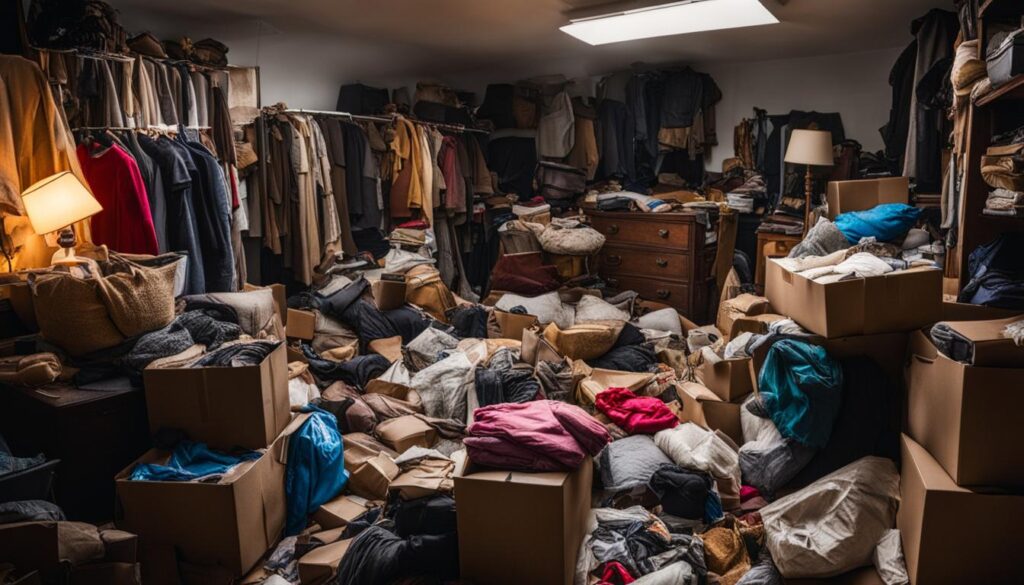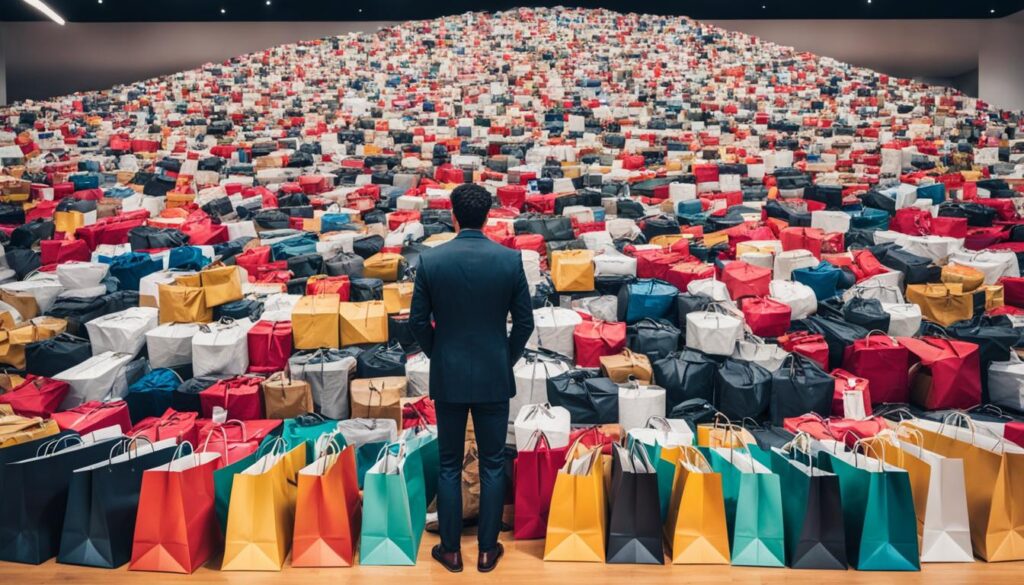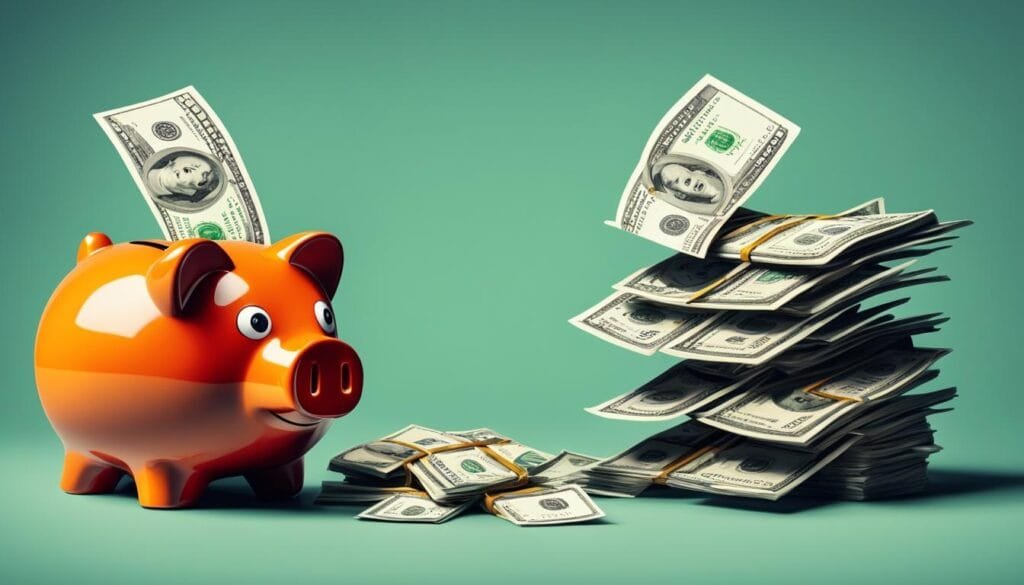Are you concerned that you or someone you know may be struggling with a shopping addiction? It’s important to recognize the signs and symptoms of this behavioral addiction to seek the necessary help and support. Shopping addiction, also known as oniomania or compulsive buying disorder, can have serious consequences that go beyond excessive spending.
People with shopping addiction often experience a rush or euphoria when making purchases. They may use shopping as a way to cope with negative emotions or thoughts, constantly think about money, and feel guilty or ashamed after a spending spree. While shopping addiction is not officially recognized as a distinct diagnosis in the Diagnostic and Statistical Manual, it is a real and potentially problematic condition that requires attention.
Key Takeaways:
- Shopping addiction is a behavioral addiction that can have serious consequences.
- Common signs include using shopping to cope with negative emotions, thinking obsessively about money, and feeling guilty after spending sprees.
- Shopping addiction stimulates the brain’s pleasure and reward centers, similar to other behavioral addictions.
- While not officially recognized in the DSM-5, shopping addiction is a real and problematic condition that requires attention.
- Seeking professional help is crucial for individuals struggling with shopping addiction.
How Behavioral Addictions Work
Behavioral addictions, like shopping addiction, occur when certain behaviors stimulate the brain’s pleasure center and lead to feelings of satisfaction. This pleasure response is similar to the release of dopamine that occurs with addiction to substances such as drugs or alcohol. The brain’s reward and pleasure centers play a crucial role in the development of addictive behaviors.
When an individual engages in a pleasurable activity, such as shopping, the brain releases dopamine, a neurotransmitter associated with reward and pleasure. This surge of dopamine creates a pleasurable sensation, reinforcing the behavior and making it more likely to be repeated.
The desire to experience this “high” can become compulsive, causing individuals to lose control and engage in the addictive behavior despite negative consequences. In the case of shopping addiction, the brain’s reward and pleasure centers are specifically stimulated during the buying process, leading to the development of compulsive buying behavior.
How Shopping Addiction is Defined
While gambling addiction is the only officially recognized behavioral addiction in the DSM-5, ongoing research is being conducted on shopping addiction or compulsive buying disorder. It is essential to acknowledge that shopping addiction can have severe consequences similar to substance addiction. Not all shopping addicts prioritize materialistic or status-related purchases; some may be fixated on designer brands, while others are driven by finding deals. The prevalence of advertisements promoting material ownership can be particularly challenging for individuals struggling with compulsive buying disorder.
| Consequences of Shopping Addiction | |
|---|---|
| Financial strain and potential debt | |
| Difficulty breaking the cycle | |
| Negative impact on relationships | |
| Emotional distress and guilt |
Shopping addiction can have significant consequences, including financial strain leading to potential debt, the difficulty of breaking the cycle of excessive spending, strain on relationships caused by financial problems, and emotional distress and guilt after a shopping spree. It is crucial to address shopping addiction promptly and seek professional help to prevent further harm.
Types of Shopping Addictions
Not all shopping addictions manifest in the same way or for the same reasons. There are different types of shopping addictions that individuals may struggle with. Understanding these different types can help shed light on the unique challenges faced by those with a shopping addiction.
Compulsive Shopping
Compulsive shopping is a common form of shopping addiction. It involves using shopping as a means to escape negative emotions or fill a void. Individuals who engage in compulsive shopping often find temporary relief and a sense of control through their purchases. However, this behavior can quickly spiral out of control, leading to financial and emotional distress.
Impulse Buying
Impulse buying is characterized by the urge to make a purchase on a whim, without much thought or planning. It occurs as a spur-of-the-moment reaction to seeing something desirable. Individuals who struggle with impulse buying often get caught up in the excitement of the moment and give in to their impulses, even if they don’t need the item.
Bulimic Shopping
Bulimic shopping involves buying items and then quickly returning or damaging them. This type of shopping addiction is often driven by a lack of self-control and a need to experience the thrill of making a purchase. Individuals who engage in bulimic shopping may feel a temporary high from the act of buying, but it is quickly followed by feelings of regret and guilt.
Bargain-Hunting
For some individuals, the thrill of finding a great deal becomes addictive. Bargain-hunters are driven by the excitement of scoring a discount or getting more value for their money. They may buy items they don’t need simply because the price seems too good to pass up. This type of shopping addiction can lead to excessive spending and cluttered homes filled with unused items.
Collectors
Some individuals develop a shopping addiction centered around collecting items. They feel compelled to buy multiple versions of the same item to complete a set or fulfill their desire to possess every variation. Collectors may become obsessed with acquiring new items for their collection, often at the expense of their financial well-being.
Online Shopping Addiction
In today’s digital age, online shopping addiction has become increasingly prevalent. The ease and accessibility of online stores make it tempting for those with a shopping addiction to overspend. With just a few clicks, individuals can indulge their desire to shop, often without the same level of self-awareness and control as they would have in a physical store.

As illustrated above, different types of shopping addictions can manifest in various ways, each with its unique set of challenges. Understanding these types can help individuals recognize their patterns of behavior and seek the necessary support to overcome their shopping addiction.
Shopping Addiction Signs and Risk Factors
Recognizing the signs of a shopping addiction is crucial in understanding and addressing this behavioral disorder. Several common signs indicate the presence of a shopping addiction:
- Shopping or spending money as a result of negative emotions
- Obsessive thoughts about money
- Buying items to improve self-esteem
- Feeling a rush or euphoria when spending
- Experiencing guilt or shame after a spending spree
These signs often manifest in individuals with a shopping addiction and can have detrimental effects on their financial and emotional well-being. However, there are also various risk factors that contribute to the development of shopping addiction:
- Genetics: Some individuals may be more predisposed to addictive behaviors, including shopping addiction, due to genetic factors inherited from their parents.
- Co-occurring illnesses: Shopping addiction can frequently coexist with mood disorders such as depression and anxiety disorders. These underlying mental health conditions can contribute to the development and exacerbation of shopping addiction.
- Societal pressures: Living in a consumer-driven society that places a high value on material possessions can increase the risk of developing a shopping addiction. The constant bombardment of advertisements and societal expectations can create a cycle of excessive shopping.
Understanding the signs and risk factors associated with shopping addiction is essential in addressing the disorder and seeking appropriate help. By recognizing these indicators, individuals can take steps towards recovery and regain control over their lives.
Consequences of Shopping Addiction
Shopping addiction can have substantial consequences on various aspects of an individual’s life. Those struggling with this addiction often find themselves spending over budget, leading to financial strain and a potential spiral into debt. The cycle of overspending becomes difficult to break, and feelings of guilt and shame may follow a shopping spree.
The negative impact on relationships is a common consequence of shopping addiction. Excessive spending can cause arguments and conflicts with partners, friends, and family members, particularly when financial problems arise from this behavior. It is crucial to address and seek help for shopping addiction to prevent further harm.
One of the best ways to understand the consequences of shopping addiction is through data and statistics. The table below highlights some of the alarming consequences and challenges faced by individuals struggling with a shopping addiction:
| Consequences | Statistics |
|---|---|
| Financial Strain | Over 60% of shopping addicts report spending over their budget regularly. |
| Drowning in Debt | Approximately 75% of individuals with shopping addictions have accumulated significant debt. |
| Struggling to Break the Cycle | Less than 10% of shopping addicts successfully break free from their addiction without professional help. |
| Negative Impact on Relationships | Over 50% of individuals with shopping addictions experience relationship conflict related to financial problems caused by excessive spending. |
To prevent the consequences of shopping addiction, it is crucial to address the underlying issues and seek support from professionals who specialize in addiction. Overcoming this addiction requires a combination of therapy, lifestyle changes, and self-reflection.

Are You a Shopaholic? Seven Signs to Watch Out For
Shopping addiction, also known as compulsive buying disorder, can have a profound impact on individuals and their loved ones. If you suspect that you or someone you know may be struggling with a shopping addiction, it’s important to recognize the signs. Here are seven key indicators that may suggest a shopaholic tendency:
- Unopened or Tagged Items: Do you often find unopened packages or items with tags still attached in your possession? This could be a sign of impulsive buying, where purchases are made without much thought or consideration.
- Frequent Impulsive Buying: Do you frequently find yourself purchasing things you don’t need or hadn’t planned to buy? This impulsive behavior is a common characteristic of shopping addiction.
- Experiencing a Shopper’s High: Do you feel a rush of excitement or euphoria when making a purchase? This “shopper’s high” can lead to a cycle of addiction, as the pleasure derived from shopping becomes addictive.
- Feelings of Remorse: After a shopping spree, do you often feel remorse or guilt? This emotional response is common among shopaholics and can contribute to ongoing cycles of addiction.
- Conflicts with Partners: Excessive spending can strain relationships, leading to conflicts with partners over financial matters. Shopaholics may struggle to control their spending habits, which can cause tension in relationships.
- Using Retail Therapy: Do you use shopping as a form of “retail therapy” to cope with stress, anxiety, or other negative emotions? Retail therapy may temporarily alleviate negative feelings, but it can also reinforce addictive behavior.
- Anxiety or Irritability when Unable to Shop: Do you feel anxious or irritable when you can’t shop? This reliance on shopping as a source of emotional relief indicates a potential shopping addiction.
- Hiding Shopping Habits: Do you go to great lengths to hide your shopping habits from others? This secretive behavior is often a red flag for addiction and indicates a loss of control over shopping habits.
If any of these signs resonate with you or someone you know, it may be important to seek professional help. Shopping addiction can have significant consequences, and addressing the issue early on is crucial for recovery and emotional well-being.
Seeking Professional Help and Support
It’s important to remember that you’re not alone in your struggle with shopping addiction. There are resources available to help you overcome this challenge. Consider reaching out to a licensed therapist or counselor experienced in treating addiction. They can guide you through the recovery process, help you develop healthier coping mechanisms, and provide support on your journey towards breaking free from the chains of shopping addiction.

So, what are some common signs of shopping addiction that people should look out for?
Recognizing shopping addiction signs can be crucial in identifying a problem. Some common signs include compulsive buying, excessive spending, hiding purchases, and feeling guilty or anxious about shopping habits. Constantly seeking retail therapy or using shopping as a way to cope with emotions are also red flags.
Conclusion
Shopping addiction is a serious issue that can have significant consequences for individuals. It is crucial to recognize the signs of a shopping addiction and take the necessary steps to seek help and make positive changes.
One of the first steps in overcoming a shopping addiction is finding alternative activities to replace compulsive shopping. Engaging in hobbies, exercise, or spending time with loved ones can help redirect the focus away from shopping. By finding healthier outlets for emotions and stress, individuals can break the cycle of excessive spending.
Identifying triggers is also crucial in overcoming a shopping addiction. Understanding what emotions, situations, or thoughts drive the urge to shop can empower individuals to develop healthier coping mechanisms. Additionally, removing temptation by limiting shopping trips or avoiding online stores can help minimize the opportunities for impulsive buying.
While self-help methods can be effective for some, seeking professional help from a licensed therapist or counselor is often crucial in overcoming a shopping addiction. These professionals can provide personalized guidance, support, and strategies tailored to the individual’s unique needs. With the right help and support, individuals can regain control over their financial and emotional well-being and overcome a shopping addiction for good.
FAQ
What are the signs of shopping addiction?
Signs of shopping addiction may include using shopping as a way to cope with negative emotions, obsessively thinking about money, feeling a rush or euphoria when spending, and experiencing guilt or shame after a spending spree.
How do behavioral addictions work?
Behavioral addictions, including shopping addiction, stimulate the brain’s pleasure center and release dopamine, leading to feelings of satisfaction and a desire to engage in the addictive behavior.
Is shopping addiction recognized as an official diagnosis?
Shopping addiction is not currently recognized as a distinct diagnosis in the Diagnostic and Statistical Manual (DSM-5), but ongoing research is being conducted on compulsive buying disorder.
What are the different types of shopping addictions?
There are various types of shopping addictions, including compulsive shopping, impulse buying, bulimic shopping, bargain-hunting, collectors, and online shopping addiction.
What are the risk factors for shopping addiction?
Risk factors for shopping addiction can include genetics, co-occurring illnesses such as mood disorders and anxiety disorders, and societal pressures that emphasize material possessions.
What are the consequences of shopping addiction?
Shopping addiction can lead to financial strain, debt, difficulty breaking the cycle of overspending, and negative impacts on relationships due to conflicts over excessive spending.
What are the signs of being a shopaholic?
Signs of being a shopaholic may include having many unopened or tagged items, frequently purchasing unnecessary items, feeling a rush of excitement when making a purchase, and hiding shopping habits from others.
How can shopping addiction be addressed and treated?
Shopping addiction can be addressed by finding alternative activities, identifying triggers for excessive spending, removing temptation, and seeking professional help from a licensed therapist or counselor.

